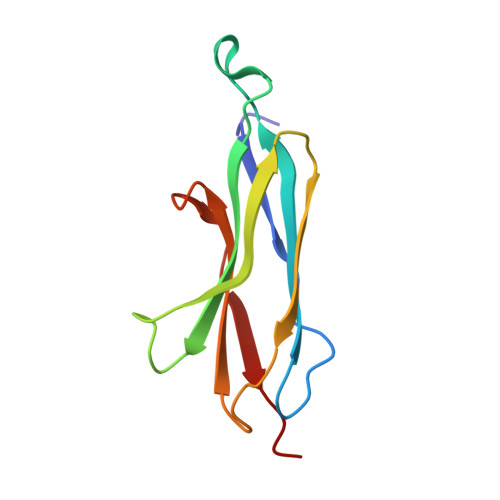Unique Fn3-like biosensor in sigma I /anti-sigma I factors for regulatory expression of major cellulosomal scaffoldins in Pseudobacteroides cellulosolvens.
Dong, S., Chen, C., Li, J., Liu, Y.J., Bayer, E.A., Lamed, R., Mizrahi, I., Cui, Q., Feng, Y.(2024) Protein Sci 33: e5193-e5193
- PubMed: 39470320
- DOI: https://doi.org/10.1002/pro.5193
- Primary Citation of Related Structures:
7CG1, 7CG5, 7CG8 - PubMed Abstract:
Lignocellulolytic clostridia employ multiple pairs of alternative σ/anti-σ (SigI/RsgI) factors to regulate cellulosomal components for substrate-specific degradation of cellulosic biomass. The current model has proposed that RsgIs use a sensor domain to bind specific extracellular lignocellulosic components and activate cognate SigIs to initiate expression of corresponding cellulosomal enzyme genes, while expression of scaffoldins can be initiated by several different SigIs. Pseudobacteroides cellulosolvens contains the most complex known cellulosome system and the highest number of SigI-RsgI regulons yet discovered. However, the function of many RsgI sensor domains and their relationship with the various enzyme types are not fully understood. Here, we report that RsgI4 from P. cellulosolvens employs a C-terminal module that bears distant similarity to the fibronectin type III (Fn3) domain and serves as the sensor domain. Substrate-binding analysis revealed that the Fn3-like domain of RsgI4 represents a novel carbohydrate-binding module (CBM) that binds to a wide range of polysaccharide types. Structure determination further revealed that the Fn3-like domain belongs to the type B group of CBMs with a predicted concave face for substrate binding. Promoter sequence analysis of cellulosomal genes revealed that SigI4 is responsible for cellulosomal regulation of major scaffoldins rather than enzymes, consistent with the broad substrate specificity of the RsgI4 sensor domain. Notably, scaffoldins are invariably required as cellulosome components regardless of the substrate type. These findings suggest that the intricate cellulosome system of P. cellulosolvens comprises a more elaborate regulation mechanism than other bacteria and thus expands the paradigm of cellulosome regulation.
- CAS Key Laboratory of Biofuels, Shandong Provincial Key Laboratory of Synthetic Biology, Qingdao Institute of Bioenergy and Bioprocess Technology, Chinese Academy of Sciences, Qingdao, China.
Organizational Affiliation:


















